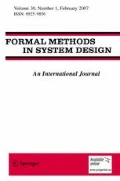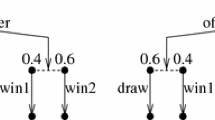Abstract
Recently, alternating transition systems are adopted to describe control systems with disturbances and their finite abstract systems. In order to capture the equivalence relation between these systems, a notion of alternating approximate bisimilarity is introduced. This paper aims to establish a modal characterization for alternating approximate bisimilarity. Based on this result, we provide a link between specifications satisfied by the samples of control systems with disturbances and their finite abstractions. Moreover, a simple example is given to illustrate the application of such link in the design of controller of control systems.



Similar content being viewed by others
Notes
By Definition 1, it is easy to see that both \(Q_{1}\cap Q'_{1}\) and \(Q_{2}\cap Q'_{2}\) are singleton. Therefore, \((Q_{1}\cap Q'_{1})\times(Q_{2}\cap Q'_{2})\) is single.
\(\sigma_{1}\sim^{\varepsilon}_{\mathit{Ag}}\sigma_{2}\) if and only if for any \(i\in\mathbb{N}\), \(\sigma_{1}[i]\sim^{\varepsilon}_{\mathit{Ag}}\sigma _{2}[i]\). Similarly, \(s_{1}\sim^{\varepsilon}_{\mathit{Ag}} s_{2}\) if and only if \(s_{1}[i]\sim^{\varepsilon}_{\mathit{Ag}} s_{2}[i]\) for any i≤max{|s 1|,|s 2|}.
⋁ i∈I φ i and ⋀ i∈I φ i can be defined as usual, where I is a finite index set.
In some situation, we can just observe the sampling system rather than control system with disturbances. Then, it may be reasonable to require that the sample satisfies specifications under such controller.
As usual, ||y||=max{y1,y2} for y=(y1 y2)′.
References
Aczel P, Mendler N (1989) A final coalgebra theorem. In: Proceedings of the category theory and computer science. Springer, Berlin, pp 357–365
Alur R, Henzinger T, Kupferman O, Vardi M (1998) Alternating refinement relations. In: Proceedings of the international conference on concurrency theory (CONCUR). Springer, Berlin, pp 165–178
Alur R, Henzinger T, Lafferriere G, Pappas G (2000) Discrete abstractions of hybrid systems. Proc IEEE 88(7):971–984
Alur R, Henzinger T, Kupferman O (2002) Alternating-time temporal logic. J ACM 49(5):672–713
Borri APG, Di Benedetto M (2012) Symbolic models for nonlinear control systems affected by disturbances. Int J Control 85(10):1422–1432
Breugel F van (2005) A behavioural pseudometric for metric labelled transition systems. In: Proceedings of the international conference on concurrency theory (CONCUR). Springer, Berlin, pp 141–155
Breugel F van, Worrell J (2005) A behavioural pseudometric for probabilistic transition systems. Theor Comput Sci 331(1):115–142
Breugel F van, Sharma B, Worrell J (2008) Approximating a behavioural pseudometric without discount for probabilistic systems. Log Methods Comput Sci 4(2:2):1–23
Cámara J, Girard A, Gössler G (2011) Synthesis of switching controllers using approximately bisimilar multiscale abstractions. In: Proceedings of the 14th international conference on hybrid systems: computation and control. ACM, New York, pp 191–200
De Alfaro L, Faella M, Stoelinga M (2009) Linear and branching system metrics. IEEE Trans Softw Eng 35(2):258–273
Desharnais J (1999) Labelled Markov processes. Ph.D. thesis, McGill University
Desharnais J, Gupta V, Jagadeesan R, Panangaden P (2004) Metrics for labelled Markov processes. Theor Comput Sci 318(3):323–354
Giacalone A, Jou CSS (1990) Algebraic reasoning for probabilistic concurrent systems. In: Proceedings of the IFIPWG 2.2/2.3 working conf. on programming concepts and methods, Sea of Gallilee. North-Holland, Amsterdam, pp 443–458
Girard A (2005) Reachability of uncertain linear systems using zonotopes. In: Hybrid systems: computation and control. Springer, Berlin, pp 291–305
Girard A (2007) Approximately bisimilar finite abstractions of stable linear systems. In: Proceedings of the hybrid systems: computation and control. IEEE Press, New York, pp 231–244
Girard A, Metrics for approximate transition systems simulation and equivalence (MATSSE). http://ljk.imag.fr/membres/Antoine.Girard/Software/Matisse/index.html
Girard A, Pappas G (2007) Approximation metrics for discrete and continuous systems. IEEE Trans Autom Control 52(5):782–798
Girard A, Pappas G (2009) Hierarchical control system design using approximate simulation. Automatica 45(2):566–571
Girard A, Pappas G (2011) Approximate bisimulation: a bridge between computer science and control theory. Eur J Control 17(5):568–578
Hennessy M, Milner R (1985) Algebraic laws for nondeterminism and concurrency. J ACM 32(1):137–161
Kloetzer M, Belta C (2008) Dealing with nondeterminism in symbolic control. In: Proceedings of the hybrid systems: computation and control. Springer, Berlin, pp 287–300
König D (1936) Theorie der endlichen und unendlichen Graphen: Kombinatorische Topologie der Strekenkomplexe
Larsen K, Yi W (1994) Time abstracted bisimulation: implicit specifications and decidability. In: Proceeding of the mathematical foundations of programming semantics. Springer, Berlin, pp 160–176
Park D (1981) Concurrency and automata on infinite sequences. In: Proceedings of the 5th GI-conference on theoretical computer science. Springer, Berlin, pp 167–183
Pola G, Tabuada P (2008) Symbolic models for nonlinear control systems affected by disturbances. In: Proceedings of the 47th IEEE conference on decision and control. IEEE Press, New York, pp 251–256
Pola G, Tabuada P (2009) Symbolic models for nonlinear control systems: alternating approximate bisimulations. SIAM J Control Optim 48:719–733
Pola G, Girard A, Tabuada P (2008) Approximately bisimilar symbolic models for nonlinear control systems. Automatica 44(10):2508–2516
Tabuada P (2008) An approximate simulation approach to symbolic control. IEEE Trans Autom Control 53(6):1406–1418
Tabuada P, Pappas G (2003) Finite bisimulations of controllable linear systems. In: Proceedings of the 42nd IEEE conference on decision and control, 2003, vol 1. IEEE Press, New York, pp 634–639
Tabuada P, Pappas G (2003) From discrete specifications to hybrid control. In: Proceedings of the 42nd IEEE conference on decision and control, 2003, vol 4. IEEE Press, New York, pp 3366–3371
Tabuada P, Pappas G (2006) Linear time logic control of discrete-time linear systems. IEEE Trans Autom Control 51(12):1862–1877
Wang Y (1990) Real-time behaviour of asynchronous agents. In: Proceedings of the international conference on concurrency theory (CONCUR). Springer, Berlin, pp 502–520
Ying M (2002) Bisimulation indexes and their applications. Theor Comput Sci 275(1–2):1–68
Ying M (2005) π-Calculus with noisy channels. Acta Inform 41(9):525–593
Ying M, Feng Y, Duan R, Ji Z (2009) An algebra of quantum processes. ACM Trans Comput Log 10(3):1–36
Zhang J, Zhu Z (2007) A modal characterization of λ-bisimilarity. Int J Softw Inform 1(1):85–99
Zhang J, Zhu Z (2008) A behavioural pseudometric based on λ-bisimilarity. Electron Notes Theor Comput Sci 220(3):115–127
Zhang J, Zhu Z (2008) Characterize branching distance in terms of (η,α)-bisimilarity. Inf Comput 206(8):953–965
Zhou C, Ying M (2012) Approximating Markov processes through filtration. Theor Comput Sci 446:75–97
Acknowledgements
The authors are grateful to the anonymous referees for their valuable suggestions, which have helped us to improve the presentation of the paper. In particular, the approach of linear temporal logical control is perfected with the help of the anonymous referees.
Author information
Authors and Affiliations
Corresponding author
Additional information
This work received financial support of the National Natural Science of China (No. 60973045), Fok Ying-Tung Education Foundation, the NSF of Jiangsu Province (No. BK2012473), the PAPD of Jiangsu Higher Education Institutions (No. YSXKKT27), and the NSF of the Jiangsu Higher Education Institutions (No. 13KJB520012).
Rights and permissions
About this article
Cite this article
Zhang, J., Zhu, Z. A modal characterization of alternating approximate bisimilarity. Form Methods Syst Des 44, 240–263 (2014). https://doi.org/10.1007/s10703-013-0201-9
Published:
Issue Date:
DOI: https://doi.org/10.1007/s10703-013-0201-9




